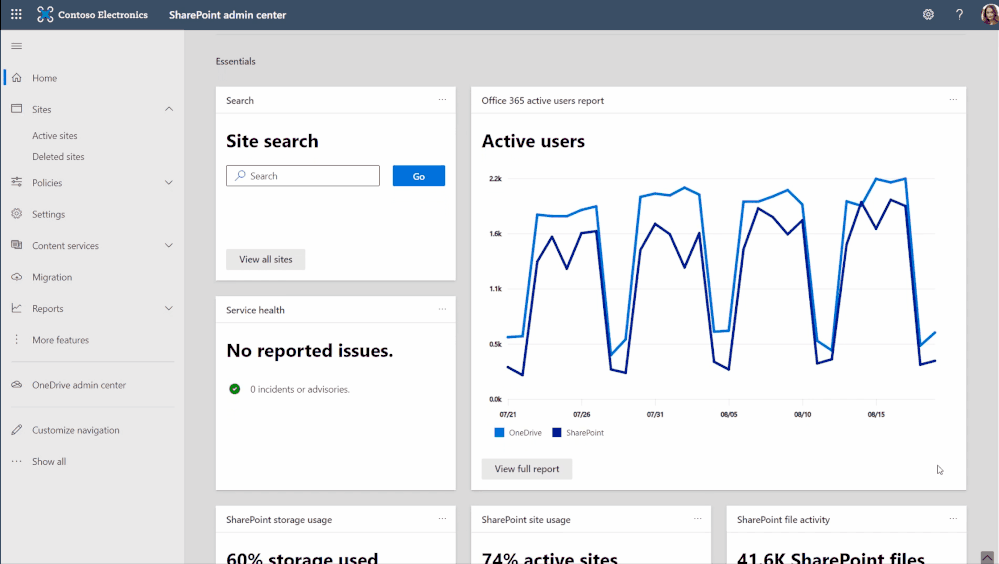How to Merge Your OneDrive & SharePoint Admin Centers

Over the years, it’s become very evident that the number of active users of Microsoft SharePoint and OneDrive has increased significantly. In 2020, it was announced that there were over 200 million monthly active users and counting. While SharePoint has played a major role in creating dynamic sites for different departments, OneDrive has been a platform for storage and collaboration.
However, as the number of users rises, it’s now harder than ever for platform admins to monitor each simultaneously. Can you imagine how confusing it is to jump from one admin center to another to handle governance on both SharePoint and OneDrive?
As part of a continuous development effort from Microsoft, this February they are giving organizations the power to manage their OneDrive from the SharePoint admin center. Let’s check how you can start setting up this integration and what the key benefits are.

A Unified OneDrive and SharePoint Admin Center
Microsoft aims to bring an improved and integrated admin center where managing both OneDrive and SharePoint can be done in one place; you can govern everything at an organizational level without the need to switch between the two. There are a bunch of admin tasks you can do such as managing storage limits, controlling internal and external sharing, configuring retention policies, managing sync controls for OneDrive, and more.
Aside from these capabilities, another good thing about this new consolidated control center is the improved user interface with an enhanced reporting feature. They’re also including a new built-in role in this release called the Global Reader admin role which provides a read-only view of the SharePoint admin center where users can view all the settings and administrative information but won’t be able to edit or modify it.
Here’s a quick view of the consolidated SharePoint and OneDrive admin center:

On the SharePoint admin center homepage, you can now add widgets and actionable OneDrive cards along with your SharePoint widgets. From the above image, you can see that there‘s OneDrive information such as usage and user activity. This will allow you to easily access and monitor OneDrive activity information directly from the admin center.
Wondering what you can do more in this new feature? Here’s a quick guide to have a merged admin center for both OneDrive and SharePoint.
Configure Sync, Retention, and Storage Settings
Easily set up the syncing of your files in OneDrive and SharePoint by going to the SharePoint admin center > Settings where you will see the options to show the Sync button on the OneDrive website, allow syncing only on computers in specific domains, and even block uploading of specific file types.
Aside from syncing your files, on this page you can also set the retention policies for both SharePoint and OneDrive content. Easily define the default retention period for the content of users who are no longer part of your organization for compliance. You can also set your default storage limit on this page to prevent going beyond capacity.

Manage Sharing and Permission Control
On the same page, you will now be able to manage sharing settings for both SharePoint and OneDrive. It will now be easier for admins to manage internal and external sharing for both platforms in one center. To proceed, just go to the SharePoint admin center > Policies > Sharing as shown in the image below. Here you can set the sharing permissions from least to most permissive for SharePoint and OneDrive content.

Aside from the easy configuration of content sharing, there are other sharing options you can leverage such as limiting external sharing by domain, allowing guests to share items they don’t own, and more.
This admin center integration will surely help administrators of both SharePoint and OneDrive govern the two platforms efficiently and should save admins a lot of time instead of switching between two different admin centers. Make sure to check out this new feature this coming soon!
For more Microsoft 365 updates subscribe to our blog!
Adrian is currently a member of AvePoint's project management team. In his previous role as a Content Marketing specialist at AvePoint, Adrian covered the latest trends and topics on what’s new in technology, SaaS Management & Governance, SaaS Backup and Data Management.




